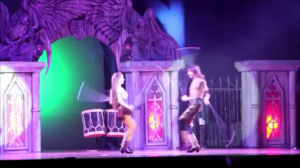Gaucho show El Malambo celebrates the culture of the Gauchos in a dance and music spectacle of raw power and imaginative brio.
The show is comprised of “dance duels” between gauchos, the cowboys. The dance marked by aggression, passion, and courage sees performers face-off through dance. The intensity of the performance is increased through the rhythm of “Malambo”, with roots in African and Indigenous cultures.
The truly passionate show is high-in-demand for galas, corporate events and private parties.
Available in Bahrain, Saudi Arabic, the rest of the GCC, Maldives, Macao and other international locations such as Hong Kong.
TO BOOK GAUCHO SHOW EL MALAMBO CLICK HERE
Gaucho Show El Malambo incorporates and refines these complex moves, but the most spectacular effect in its high-octane show comes from the use of percussive boleadoras. “Boleadoras were a weapon used for battle by Indigenous people but also for hunting.”
Gauchos were the ranchers of the Pampas—the prairies of the cone of South America that stretch from Patagonia to the Andes Mountains, and as far north as the Rio Grande do Sul in Brazil. Gaucho show El Malambo celebrates the culture of the Gauchos in a dance and music spectacle of raw power and imaginative brio.
“The gaucho was a free man and a loner,” “He was nomadic and went wherever he needed or wanted, working when and where it suited him. When he got hungry he just killed a cow. He liked to keep things simple and wore two ponchos, one over his upper body, and one over his lower body. He lived, worked, and even slept in the saddle. When a gaucho needed the money he sold some hides at one of the small bars at the crossroads in the Pampas.
There were dance duels between gauchos. The two men would face off, one performing a sequence of movements and steps as a challenge, which the other replied to immediately, replicating or changing or broadening it. Such “conversations” between artists are regularly found in the stage shows of contemporary rock or jazz acts, but with the gauchos, the exchanges were more intense and personal in character. The rhythm they danced to was the Malambo, with roots in African and Indigenous cultures, striking the floor with their boots like flamenco dancers, and wandering aimlessly their legs with apparently unimaginable adaptability at lightning speed.
Gaucho Show El Malambo incorporates and refines these complex moves, but the most spectacular effect in its high-octane show comes from the use of percussive boleadoras. “Three leather thongs about two meters long, joined at one end and with pouches attached to the free ends, each enclosing a stone the size of a fist. When cast at the legs of an animal or an enemy it wrapped tightly around them.
The first part of our show introduce the more traditional aspects of the dance,in structure and soul, while in the second part, which we call the Fiesta, we convey a grin to it.
Gaucho show El Malambo isn’t a fixed ballet, it’s a living ballet, an organism, a beating heart—because the Malambo rhythm is pulsating heart—on the grounds that the Malambo cadence is over every one of the heartbeats, and we imagine that is for what reason we’re so generally welcomed on galas, corporate events, and weddings.







